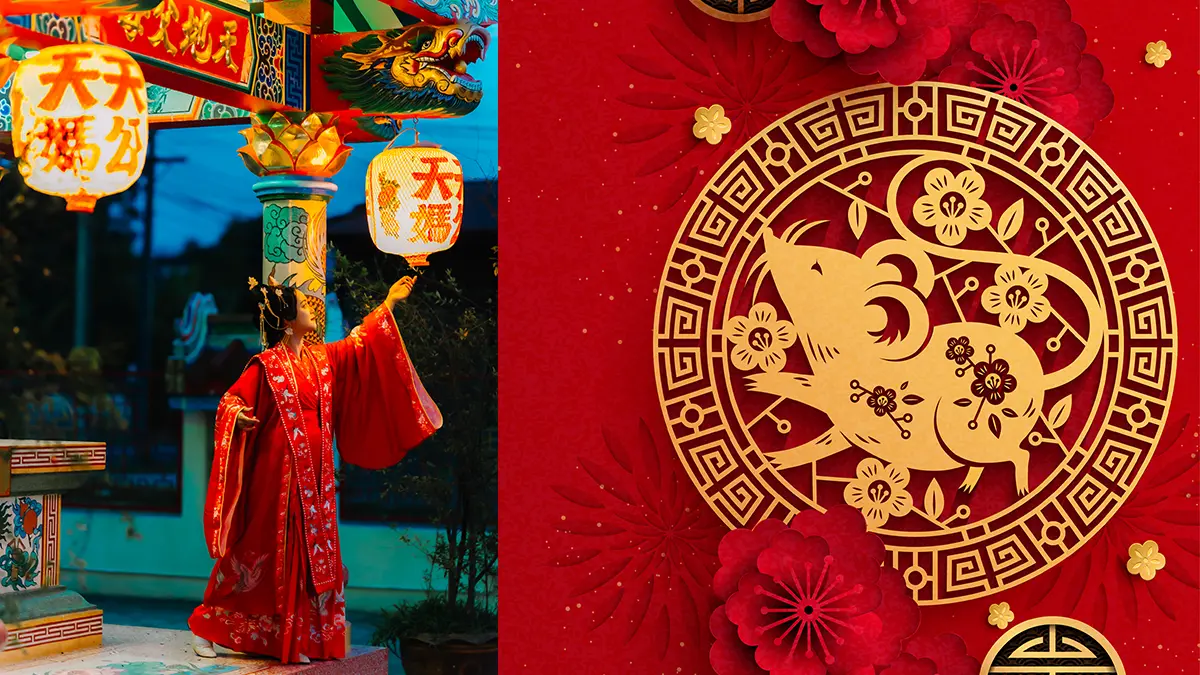New Year rituals worldwide, like midnight kisses and eating grapes, aim to attract good fortune and love for the coming year.
Symbolic foods, such as black-eyed peas and round fruits, are believed to bring prosperity and financial stability when consumed on New Year’s Eve.
Cultural practices like opening doors at midnight and jumping off chairs help to banish bad spirits and start the year fresh and positive.

As the clock strikes midnight on New Year’s Eve, many cultures around the world partake in unique rituals to ensure good fortune for the coming year. These midnight traditions are deeply ingrained in cultural practices and are believed to set the tone for the year ahead.
In Spain, it is customary to eat twelve grapes at midnight, one for each stroke of the clock, to welcome good luck and prosperity for each month ahead. This tradition is also found in various Latin countries and Italy, where it is believed to bring luck in love throughout the year.
Another widely practiced ritual is the midnight kiss. Sharing a kiss at midnight is believed to ensure that sentiments of love persist throughout the year.
Other cultures have their unique ways of welcoming the new year. In Ireland, for example, leaving doors open at midnight is a tradition that symbolizes welcoming fresh beginnings and good fortune.
These rituals, whether simple or elaborate, all share a common goal – to bring good fortune and happiness in the new year.
Symbolic foods play a significant role in New Year’s superstitions, with each culture having its own unique dishes believed to bring prosperity and good fortune. Food is not just sustenance; it is a symbol of the riches and abundance that people hope to attract in the upcoming year.
One popular tradition is eating 12 grapes at midnight, a practice common in various Latin countries and Italy. Each grape represents a month of the year, and consuming them is believed to bring luck and prosperity. Another interesting practice is found in Filipino culture, where 12 round fruits are eaten on New Year’s Eve to symbolize the months of the year and attract wealth.
In the Southern United States, black-eyed peas and collard greens are traditional New Year’s foods. Black-eyed peas symbolize coins, while collard greens represent paper money, together believed to bring financial prosperity. Pork is another food associated with good fortune on New Year’s Day due to its forward-moving behavior, symbolizing progress and abundance.
Other unique foods include marzipan pigs in Germany and Austria, which are thought to bring good luck, and Hoppin’ John, a dish of rice and red beans served in Southern and Asian New Year’s celebrations, representing prosperity. These culinary traditions reflect a universal desire for a prosperous and abundant year ahead.
Banishment of bad spirits is a common theme in New Year’s Eve superstitions. Many cultures believe that starting the year without any lingering negativity is crucial for inviting good fortune and positive energy.
One widespread practice is opening doors and windows at midnight to let the old year out and welcome new beginnings. This act symbolizes clearing out negative energy and making space for the good fortune to enter. Making loud noises at midnight, whether through fireworks, banging pots, or ringing bells, is a way to drive away evil spirits and ward off bad luck.
In Denmark, jumping off a chair at midnight is thought to chase away bad spirits as the new year begins. Meanwhile, in some cultures, knocking bread against the walls is a traditional practice to ward off evil spirits and attract good luck.
These rituals, though varied, all aim to start the new year with a clean slate and positive energy, free from the influences of bad spirits.
Financial prosperity is a common goal for many entering the new year. Various cultures have unique traditions to ensure financial stability and abundance.
In Scotland, it is believed that entering the new year without any debt brings positive fortune. This belief prompts many to aim for a debt-free start, ensuring that financial worries do not carry over into the new year. Similarly, in some cultures, placing money outside on New Year’s Eve is thought to invite wealth into the home throughout the year.
In Portugal and parts of Latin America, there’s a tradition of placing money in your shoe on New Year’s Eve. This practice is believed to ensure good fortune and financial success for the year ahead.
In Colombia, an interesting tradition involves drawing a potato from under the bed at midnight, with each type of potato signifying different financial outcomes. These diverse traditions highlight the varied cultural beliefs surrounding financial abundance at the start of the new year.

New Year’s Eve is celebrated globally with a myriad of unique customs, each believed to bring good luck and fortune in the coming year’s eve. These traditions reflect the rich cultural diversity and the universal hope for a prosperous year ahead.
One such custom is carrying an empty suitcase on New Year’s Eve, a tradition believed to ensure travel in the next 12 months. In Brazil, wearing white and jumping over seven waves at midnight is a ritual for attracting good fortune. Breaking dishes on neighbors’ doorsteps in Denmark is another unique practice thought to bring good luck to those you care about.
In the Philippines, wearing polka dots on New Year’s Eve is believed to bring wealth, with the round shapes symbolizing coins. Italians traditionally wear red on New Year’s Eve to attract good fortune and love. Despite their diversity, these customs share the common goal of starting the year with positive energy and good fortune.
Love and relationships are central to many New Year’s superstitions, with various cultures practicing rituals believed to foster affection and strengthen bonds in the upcoming year.
The midnight kiss is a widely practiced superstition, believed to strengthen romantic bonds and ensure that sentiments of love persist throughout the year. In Brazil, wearing specific colors such as red for love or white for peace is a common practice aimed at enhancing romantic prospects.
Another interesting tradition involves writing down a wish for love and burning it at midnight, believed to help manifest that desire in the new year. In Irish tradition, placing a sprig of mistletoe under the pillow on New Year’s Eve is said to cause dreams of one’s future love.
These superstitions reflect the universal hope for love and happiness in the new year, including new year’s superstitions, year’s superstitions, and new year’s eve superstitions.
House cleaning and preparation are important aspects of New Year’s superstitions. Many cultures believe that a clean and organized home sets the stage for a prosperous and happy year ahead.
Cleaning your home before the new year helps avoid bringing dirt and negativity from the previous year into the new one. Starting the New Year in a tidy home ensures you don’t carry over any unwanted negativity from the past. However, in some traditions, cleaning the house on New Year’s Eve is discouraged as it is believed that this may sweep away good fortune.
Stepping into the new year with the right foot is another practice thought to ensure a positive start and promote good fortune. These preparations reflect the desire to begin the new year fresh and with positive energy.
Weather and natural phenomena are often interpreted as omens that can influence the year ahead. These beliefs highlight the connection between nature and the hopes and fears of the coming year.
A south wind at the start of the year is believed to predict a prosperous year ahead. Conversely, winds from the east on New Year’s Day are seen as harbingers of famine and disasters. When the wind blows from the west, it suggests a year filled with ample milk and fish supplies but may also foretell the loss of an influential person.
These omens reflect the age-old practice of looking to nature for signs and predictions about the future, adding mystery and anticipation to the start of the new year.
Generosity and sharing are vital aspects of New Year’s Eve celebrations. These acts not only reinforce community bonds but also symbolize goodwill and the hope for a year filled with prosperity.
In Welsh tradition, children participate in a custom called Calennig, where they visit homes to share good wishes and receive small gifts, emphasizing the spirit of generosity. Smashing dishes against friends’ doors in Denmark is another tradition believed to bring good fortune to those you care about, highlighting community generosity.
Acts of generosity during New Year’s are essential for fostering stronger relationships and community connections, representing the collective hope for a prosperous and harmonious year ahead.
Avoiding bad luck is central to New Year’s superstitions, with many cultures having specific practices to steer clear of misfortune and ensure a positive start to the year.
One common belief is that crying on New Year’s Day sets a negative tone for the new year. Similarly, cleaning your clothes on New Year’s Eve could wash away good luck. Eating certain foods is also avoided; for example, lobster is considered bad luck since they move backward, symbolizing regression, and eating chicken is believed to scratch away good fortune.
The direction of the wind on New Year’s Day is also seen as an omen. A north wind indicates bad weather, while an east wind foretells famine and calamities. These practices and beliefs reflect the desire to start the new year with positivity and avoid any potential misfortune.
As we’ve seen, New Year’s superstitions and traditions are a fascinating mix of cultural practices aimed at bringing good luck, prosperity, and happiness. From midnight rituals and symbolic foods to acts of generosity and avoiding bad luck, these customs highlight the universal desire to welcome the new year with open arms and positive energy.
Whether you choose to adopt some of these traditions or simply appreciate their cultural significance, embracing these practices can add a touch of magic to your New Year celebrations. Here’s to a prosperous, joyful, and fortunate year ahead!
Eating 12 grapes at midnight is a fun tradition in many Latin countries and Italy, bringing good luck and prosperity for each month ahead. So, grab your grapes and enjoy the celebration!
A midnight kiss on New Year's Eve is significant because it's thought to guarantee that love and affection carry on throughout the year. So, don't miss that moment with your special someone!
Placing money in your shoes on New Year's Eve is believed to bring good fortune and financial success in the coming year. It’s a fun tradition that many cultures cherish for its positive vibes!
To banish bad spirits on New Year's Eve, you can open doors and windows, make loud noises, jump off chairs, or even knock bread against walls. These fun practices help clear out any negative energy as you welcome the new year!
Crying on New Year's Day is seen as bad luck because it can set a negative tone for the year ahead, potentially inviting misfortune. So, it’s best to start the new year with positivity!